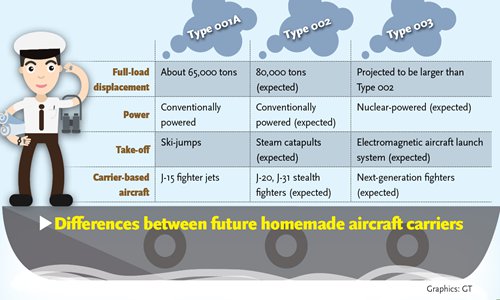
○ The construction of aircraft carriers will not stop after the commissioning of the country's recently-launched second carrier, experts say
○ The third carrier will likely still be conventionally powered but will use steam launch catapults
○ The fourth carrier is predicted to be nuclear powered and use advanced launch and lacing systems
China's second aircraft carrier, the first one to be made domestically, was recently launched and the country is on track to field a dual-aircraft carrier strike group in a couple of years. But experts believe that the new Type 001A carrier is just the start of China as a maritime power, as the country will deploy larger and more capable domestic carriers in the coming years.
"We will definitely continue to build aircraft carriers," Li Jie, a Beijing-based navy expert, told the Global Times. "The People's Liberation Army Navy (PLAN) will have more than three in the future, so as to ensure its combat ability while conducting practice and maintenance at the same time."
It has been reported that a "larger and more capable" third carrier, dubbed the Type 002, has been under construction in Shanghai since March 2015. However, this has not been officially confirmed.
In response to Global Times' questions about this third carrier, a Ministry of National Defense publicist directed the reporter to comments made by ministry spokesman Yang Yujun.
"As to the long-term development of China's aircraft carriers, relevant authorities will take various factors into consideration in making decisions," Yang said at a press conference on December 31, 2015.
More questions about carrier were posed to Yang last month, including how many aircraft carriers China aims to have in the long term, to which he essentially reiterated his previous comments.
Li declined to say whether he believes the reports about the Type 002 but said that China will eventually build third and fourth aircraft carriers.
"I think we must have five to six aircraft carriers. It will take 20 to 30 years for the PLAN to deploy all of them and be able to conduct strike group operations," Li noted.
Projections of the future carriers
Li said the Type 002 will look different from the Liaoning, a refitted Soviet-era carrier purchased from Ukraine, and the Type 001A, which resembles the Liaoning and was launched on April 26 in Dalian Shipyard in Northeast China's Liaoning Province.
"It will look more like the U.S.' aircraft carriers, rather than Russia's," Li said, predicting that it will dispense with the ski-jumps seen on the Liaoning and Type 001A and instead adopt the steam catapults that are commonly used by the U.S. navy.
The steam catapults will enable the carrier to launch heavier aircraft much quicker, Li explained.
"Its fully-loaded displacement will be about 10,000 tons larger than the Type 001A and but it will still be conventionally powered," Li predicted.
Lan Yun, deputy editor of Beijing-based magazine Modern Ships, echoed Li's opinion. "Although China is mature in using nuclear reactors on submarines, surface vessels differ greatly from underwater craft and the power system cannot be copied directly," Lan told the Global Times.
China has been progressing in short steps, instead of leaps, in developing high-tech weapons. "It's risky to make large technical changes. The design and use of nuclear reactors for carriers will take at least 15 years of research. When they are applied, repeated security tests shall be conducted to ensure absolute safety," Lan explained.
Both Li and Lan think it's possible that China will be able to have a nuclear-powered fourth carrier.
In addition, China's fourth carrier will carry fourth-generation fixed wing aircraft, warning aircraft, electronic warfare aircraft and other ship-based aircraft.
"The full-load displacement and deck of the fourth aircraft carrier will likely be larger; its stealth performance will be better," Li said. "The possibility of adopting an electromagnetic aircraft launch system (EMALS) and aircraft landing technology that may be on par with or even outclass the U.S.'s cannot be ruled out."
Li's projections are not groundless. Ma Weiming, a leading expert on ship power and electrical engineering from the Navy University of Engineering, told reporters in March in Beijing that China's EMALS is more advanced than comparable U.S. technology and the country has made breakthroughs in its electric motor-based Advanced Arresting Gear (AAG) landing system, according to the South China Morning Post.
The U.S. Navy's next-generation supercarrier USS Gerald R. Ford, which comes equipped with EMALS and AAG systems for the first time, will become the "world's most technologically advanced aircraft" after it is commissioned and will "represent a new era of American naval power," according to U.S. media reports. The ship completed its first set of sea trials in April and is expected to be delivered later this year.


















































